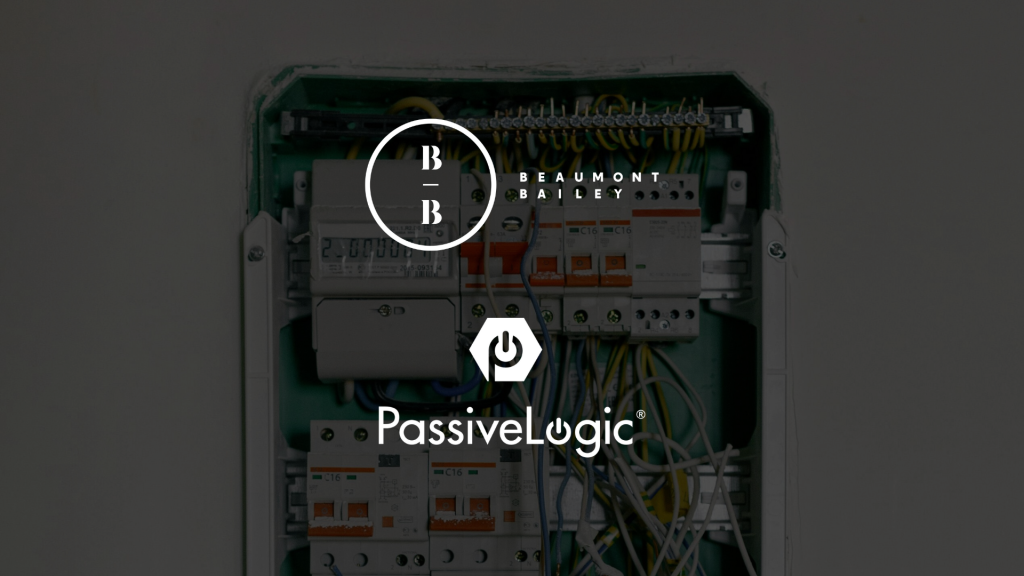Technology Spotlight: A Conversation with PassiveLogic
By Emma Callahan

 As part of Beaumont Bailey’s mission to connect founders, innovators, and key players that make up the fabric of our industry, our latest Technology Spotlight series highlights the success of our incredible members and wider network. In this instalment, we speak with Travis Hallstrom, Co-Founder and Head of Product Strategy at PassiveLogic.
As part of Beaumont Bailey’s mission to connect founders, innovators, and key players that make up the fabric of our industry, our latest Technology Spotlight series highlights the success of our incredible members and wider network. In this instalment, we speak with Travis Hallstrom, Co-Founder and Head of Product Strategy at PassiveLogic.
When we think of “autonomy,” most of us jump straight to self-driving cars. But what if buildings themselves could operate autonomously? Optimising comfort, energy use, and efficiency without constant human oversight? That’s exactly the future PassiveLogic is engineering.
I sat down with Travis Hallstrom, Head of Product Strategy and a founding team member at PassiveLogic, to talk about her journey, the company’s platform architecture, and how digital twins are transforming real estate operations at scale.
From Day One at PassiveLogic
Travis has been with PassiveLogic since the very beginning. “We really set out to solve the problem that there weren’t end-to-end technology platforms tackling controls for high performance buildings in an integrated way,” she explained.
The team set out to design an autonomous platform for buildings, combining edge hardware, digital twins, and AI-driven control strategies.
“Instead of navigating through space like an autonomous vehicle, we’re navigating through time,” she said. “We model the building with a sophisticated digital twin, based on the physics of every component, then select the optimal future trajectory for operations. The Hive edge controller executes those controls in real time, collects granular data from the building’s sensors, and feeds that data back into the model. The system then improves itself in a continuous feedback loop.”
A Platform for Every Stakeholder
Unlike traditional building management systems, which tend to be fragmented and stakeholder-specific, PassiveLogic was designed as an end-to-end stack.
“We really have services for every stakeholder and throughout the lifecycle of a building,” Travis explained. “That’s our secret sauce: we provide a single pane of glass to everyone. Because our model is comprehensive and physics-based, we can deliver insights to architects, engineers, developers, contractors, operators, and asset managers. Everyone is working off the same source of truth.”
This unification is made possible by the digital twin. Instead of multiple siloed systems, PassiveLogic creates a shared, physics-accurate model that evolves from design through operation.
Autonomy Studio + Hive: The Hardware–Software Bridge
The Autonomy Studio suite enables users to create building digital twins through multiple pathways, from CAD-based workflows to mobile scanning tools for retrofits.
For equipment manufacturers, PassiveLogic also provides a Digital Twin SDK, enabling OEMs to publish component-level twins (think HVAC systems, pumps, valves, actuators) into a shared library. These can then be specified and deployed by designers and engineers in real-world projects.
PassiveLogic has also partnered with Belimo as an ecosystem collaborator and strategic investor. Belimo’s IoT-enabled actuators, control valves, and sensors already provide digital identities, effectively digital twins, of critical HVAC components.
By integrating these IoT-enabled devices into PassiveLogic’s library, building operators can leverage component-level data in real time, feeding directly into PassiveLogic’s physics based models. This collaboration strengthens the ecosystem, allowing Autonomy Studio to pull from an expanding library of manufacturer-authenticated twins and enabling the Hive platform to run control strategies with unprecedented accuracy. Together, the two companies are aligning hardware, software, and data to maximise energy efficiency, improve indoor environmental quality, and reduce maintenance costs.
Once deployed, the digital twin runs natively on PassiveLogic’s Hive platform. “The Hive is an edge computing device installed directly in the building,” Travis explained. “It connects to every subsystem, HVAC, lighting, renewables, storage, and executes the control strategy in real time. It’s not dependent on the cloud, which is key for resilience, latency, and security. The Hive continuously gathers live sensor data, executes control sequences locally, and syncs learnings back into the digital twin.”
This local autonomy is what separates PassiveLogic from conventional cloud-based BMS overlays. The building can self-optimise and even self-heal without requiring constant human intervention.
Scaling Across Asset Classes
Traditional building management systems (BMS) are often costly, require specialised engineers, and are typically limited to large commercial towers. PassiveLogic’s approach flips that paradigm.
“We’re asset-class agnostic,” Travis emphasised. “Our platform works across commercial offices, multifamily housing, warehouses, industrial facilities, museums, and even coffee shops. Historically, many of these classes have been excluded from advanced building management because BMS deployments were too expensive and too complex. With Hive, we can scale up to the tallest skyscraper or down to the smallest retail footprint.”
By lowering the barriers to advanced controls, PassiveLogic is democratising access to building autonomy across the built environment.
Self-Diagnosing, Self-Optimising
Perhaps one of the most compelling aspects of PassiveLogic’s architecture is how it uses its digital twin for diagnostics and fault detection.
“That physics-based digital twin is essential,” Travis said. “Every component is defined by its fundamental functions and physics. If something deviates from its expected behaviour, the system can identify the issue immediately. Using generative AI, it can resolve simple problems autonomously or generate diagnostic procedures for more complex cases that require human intervention.”
This capability reduces downtime, minimises maintenance costs, and provides asset managers with a proactive view of building health rather than reactive troubleshooting.
Industry Impact: ESG, Decarbonisation, and the Aroundtown Partnership
As PassiveLogic scales, its impact goes beyond operational efficiency and is directly aligned with the real estate sector’s most pressing goals: ESG compliance, energy efficiency, and decarbonisation.
The ability to capture high-resolution operational data, model outcomes in advance, and prove measurable energy savings positions PassiveLogic as a key enabler for owners navigating increasingly stringent sustainability reporting requirements.
Most recently, PassiveLogic announced a partnership with Aroundtown, one of Europe’s largest commercial real estate companies. The collaboration highlights how institutional owners are embracing autonomy not just as a cost-saving measure but as a strategic driver for ESG performance at portfolio scale.
For a player of Aroundtown’s size, spanning offices, hotels, logistics, and residential assets, standardising operations across thousands of buildings is notoriously challenging. By deploying PassiveLogic, they can unify control strategies, optimise energy consumption, and automate compliance reporting across diverse asset classes.
This partnership underscores the broader industry shift: autonomous building platforms are moving from experimental pilots into mainstream adoption at institutional scale.
Looking Ahead
As Travis summed it up: “We’re building a virtuous cycle. Every building that runs on our platform learns, improves, and strengthens the ecosystem. Over time, this isn’t just about optimising individual assets, it’s about transforming how real estate operates at scale.”
With PassiveLogic’s recent momentum and partnerships like Aroundtown, that transformation may be happening faster than anyone expected.
 If you would like to discuss any of the topics raised in this piece, or if you need support with your leadership resourcing strategy, please get in touch with Emma Callahan on: emma.callahan@beaumontbailey.com.
If you would like to discuss any of the topics raised in this piece, or if you need support with your leadership resourcing strategy, please get in touch with Emma Callahan on: emma.callahan@beaumontbailey.com.




